[English] 日本語
 Yorodumi
Yorodumi- PDB-5uz9: Cryo EM structure of anti-CRISPRs, AcrF1 and AcrF2, bound to type... -
+ Open data
Open data
- Basic information
Basic information
| Entry | Database: PDB / ID: 5uz9 | ||||||||||||
|---|---|---|---|---|---|---|---|---|---|---|---|---|---|
| Title | Cryo EM structure of anti-CRISPRs, AcrF1 and AcrF2, bound to type I-F crRNA-guided CRISPR surveillance complex | ||||||||||||
 Components Components |
| ||||||||||||
 Keywords Keywords | IMMUNE SYSTEM/RNA / CRISPR RNA-recognition-motif (RRM) / pseudo-helical / Type 1-F CRISPR / IMMUNE SYSTEM-RNA complex | ||||||||||||
| Function / homology |  Function and homology information Function and homology informationsymbiont-mediated suppression of host adaptive immune response / symbiont-mediated suppression of host CRISPR-cas system / maintenance of CRISPR repeat elements / endonuclease activity / defense response to virus / Hydrolases; Acting on ester bonds / RNA binding Similarity search - Function | ||||||||||||
| Biological species |   Pseudomonas phage JBD30 (virus) Pseudomonas phage JBD30 (virus) Pseudomonas phage D3112 (virus) Pseudomonas phage D3112 (virus) Pseudomonas aeruginosa UCBPP-PA14 (bacteria) Pseudomonas aeruginosa UCBPP-PA14 (bacteria) | ||||||||||||
| Method | ELECTRON MICROSCOPY / single particle reconstruction / cryo EM / Resolution: 3.4 Å | ||||||||||||
 Authors Authors | Chowdhury, S. / Carter, J. / Rollins, M.F. / Jackson, R.N. / Hoffmann, C. / Nosaka, L. / Bondy-Denomy, J. / Maxwell, K.L. / Davidson, A.R. / Fischer, E.R. ...Chowdhury, S. / Carter, J. / Rollins, M.F. / Jackson, R.N. / Hoffmann, C. / Nosaka, L. / Bondy-Denomy, J. / Maxwell, K.L. / Davidson, A.R. / Fischer, E.R. / Lander, G.C. / Wiedenheft, B. | ||||||||||||
| Funding support |  United States, United States,  Canada, 3items Canada, 3items
| ||||||||||||
 Citation Citation |  Journal: Cell / Year: 2017 Journal: Cell / Year: 2017Title: Structure Reveals Mechanisms of Viral Suppressors that Intercept a CRISPR RNA-Guided Surveillance Complex. Authors: Saikat Chowdhury / Joshua Carter / MaryClare F Rollins / Sarah M Golden / Ryan N Jackson / Connor Hoffmann / Lyn'Al Nosaka / Joseph Bondy-Denomy / Karen L Maxwell / Alan R Davidson / ...Authors: Saikat Chowdhury / Joshua Carter / MaryClare F Rollins / Sarah M Golden / Ryan N Jackson / Connor Hoffmann / Lyn'Al Nosaka / Joseph Bondy-Denomy / Karen L Maxwell / Alan R Davidson / Elizabeth R Fischer / Gabriel C Lander / Blake Wiedenheft /   Abstract: Genetic conflict between viruses and their hosts drives evolution and genetic innovation. Prokaryotes evolved CRISPR-mediated adaptive immune systems for protection from viral infection, and viruses ...Genetic conflict between viruses and their hosts drives evolution and genetic innovation. Prokaryotes evolved CRISPR-mediated adaptive immune systems for protection from viral infection, and viruses have evolved diverse anti-CRISPR (Acr) proteins that subvert these immune systems. The adaptive immune system in Pseudomonas aeruginosa (type I-F) relies on a 350 kDa CRISPR RNA (crRNA)-guided surveillance complex (Csy complex) to bind foreign DNA and recruit a trans-acting nuclease for target degradation. Here, we report the cryo-electron microscopy (cryo-EM) structure of the Csy complex bound to two different Acr proteins, AcrF1 and AcrF2, at an average resolution of 3.4 Å. The structure explains the molecular mechanism for immune system suppression, and structure-guided mutations show that the Acr proteins bind to residues essential for crRNA-mediated detection of DNA. Collectively, these data provide a snapshot of an ongoing molecular arms race between viral suppressors and the immune system they target. | ||||||||||||
| History |
|
- Structure visualization
Structure visualization
| Movie |
 Movie viewer Movie viewer |
|---|---|
| Structure viewer | Molecule:  Molmil Molmil Jmol/JSmol Jmol/JSmol |
- Downloads & links
Downloads & links
- Download
Download
| PDBx/mmCIF format |  5uz9.cif.gz 5uz9.cif.gz | 2.5 MB | Display |  PDBx/mmCIF format PDBx/mmCIF format |
|---|---|---|---|---|
| PDB format |  pdb5uz9.ent.gz pdb5uz9.ent.gz | 2.1 MB | Display |  PDB format PDB format |
| PDBx/mmJSON format |  5uz9.json.gz 5uz9.json.gz | Tree view |  PDBx/mmJSON format PDBx/mmJSON format | |
| Others |  Other downloads Other downloads |
-Validation report
| Summary document |  5uz9_validation.pdf.gz 5uz9_validation.pdf.gz | 1.3 MB | Display |  wwPDB validaton report wwPDB validaton report |
|---|---|---|---|---|
| Full document |  5uz9_full_validation.pdf.gz 5uz9_full_validation.pdf.gz | 1.4 MB | Display | |
| Data in XML |  5uz9_validation.xml.gz 5uz9_validation.xml.gz | 297.9 KB | Display | |
| Data in CIF |  5uz9_validation.cif.gz 5uz9_validation.cif.gz | 483.9 KB | Display | |
| Arichive directory |  https://data.pdbj.org/pub/pdb/validation_reports/uz/5uz9 https://data.pdbj.org/pub/pdb/validation_reports/uz/5uz9 ftp://data.pdbj.org/pub/pdb/validation_reports/uz/5uz9 ftp://data.pdbj.org/pub/pdb/validation_reports/uz/5uz9 | HTTPS FTP |
-Related structure data
| Related structure data |  8624MC M: map data used to model this data C: citing same article ( |
|---|---|
| Similar structure data |
- Links
Links
- Assembly
Assembly
| Deposited unit | 
|
|---|---|
| 1 |
|
| Number of models | 5 |
- Components
Components
-CRISPR-associated protein ... , 3 types, 8 molecules ABCDEFGH
| #1: Protein | Mass: 49194.168 Da / Num. of mol.: 1 Source method: isolated from a genetically manipulated source Source: (gene. exp.)  Pseudomonas aeruginosa (strain UCBPP-PA14) (bacteria) Pseudomonas aeruginosa (strain UCBPP-PA14) (bacteria)Strain: UCBPP-PA14 / Gene: csy1, PA14_33330 / Production host:  |
|---|---|
| #2: Protein | Mass: 36244.074 Da / Num. of mol.: 1 Source method: isolated from a genetically manipulated source Source: (gene. exp.)  Pseudomonas aeruginosa (strain UCBPP-PA14) (bacteria) Pseudomonas aeruginosa (strain UCBPP-PA14) (bacteria)Strain: UCBPP-PA14 / Gene: csy2, PA14_33320 / Production host:  |
| #3: Protein | Mass: 37448.078 Da / Num. of mol.: 6 Source method: isolated from a genetically manipulated source Source: (gene. exp.)  Pseudomonas aeruginosa (strain UCBPP-PA14) (bacteria) Pseudomonas aeruginosa (strain UCBPP-PA14) (bacteria)Strain: UCBPP-PA14 / Gene: csy3, csy1-3, PA14_33310 / Production host:  |
-Anti-CRISPR protein ... , 2 types, 3 molecules IJK
| #4: Protein | Mass: 8693.734 Da / Num. of mol.: 2 Source method: isolated from a genetically manipulated source Source: (gene. exp.)  Pseudomonas phage JBD30 (virus) / Gene: JBD30_035 / Production host: Pseudomonas phage JBD30 (virus) / Gene: JBD30_035 / Production host:  #5: Protein | | Mass: 10760.481 Da / Num. of mol.: 1 Source method: isolated from a genetically manipulated source Source: (gene. exp.)  Pseudomonas phage D3112 (virus) / Gene: orf30 / Production host: Pseudomonas phage D3112 (virus) / Gene: orf30 / Production host:  |
|---|
-Protein / RNA chain , 2 types, 2 molecules LM
| #6: Protein | Mass: 21691.848 Da / Num. of mol.: 1 Source method: isolated from a genetically manipulated source Source: (gene. exp.)  Pseudomonas aeruginosa (strain UCBPP-PA14) (bacteria) Pseudomonas aeruginosa (strain UCBPP-PA14) (bacteria)Strain: UCBPP-PA14 / Gene: cas6f, csy4, PA14_33300 / Production host:  References: UniProt: Q02MM2, Hydrolases; Acting on ester bonds |
|---|---|
| #7: RNA chain | Mass: 19249.404 Da / Num. of mol.: 1 / Source method: obtained synthetically Source: (synth.)  Pseudomonas aeruginosa UCBPP-PA14 (bacteria) Pseudomonas aeruginosa UCBPP-PA14 (bacteria)References: GenBank: 115583796 |
-Details
| Sequence details | The sequence was taken from the PDB entry 4AL5 used for rigid body fitting. |
|---|
-Experimental details
-Experiment
| Experiment | Method: ELECTRON MICROSCOPY |
|---|---|
| EM experiment | Aggregation state: PARTICLE / 3D reconstruction method: single particle reconstruction |
- Sample preparation
Sample preparation
| Component | Name: Anti-CRISPRs AcrF1 and AcrF2 bound P. aeruginosa crRNA-guided CRISPR surveillance(Csy)complex. Type: COMPLEX Details: Cas5F, Cas6F, Cas7F, Cas8F and CRISPR RNA (crRNA) forms the Csy surveillance complex. Cas5F, Cas8F and 5'crRNA handle forms the "tail" of the complex, and 3' crRNA stem-loop along with Cas6F ...Details: Cas5F, Cas6F, Cas7F, Cas8F and CRISPR RNA (crRNA) forms the Csy surveillance complex. Cas5F, Cas8F and 5'crRNA handle forms the "tail" of the complex, and 3' crRNA stem-loop along with Cas6F forms the "head". Six copies Cas7F along with crRNA spacer forms the "core" of the complex. Entity ID: all / Source: RECOMBINANT | ||||||||||||||||||||
|---|---|---|---|---|---|---|---|---|---|---|---|---|---|---|---|---|---|---|---|---|---|
| Molecular weight | Value: 0.45 MDa / Experimental value: NO | ||||||||||||||||||||
| Source (natural) | Organism:  Pseudomonas aeruginosa UCBPP-PA14 (bacteria) Pseudomonas aeruginosa UCBPP-PA14 (bacteria) | ||||||||||||||||||||
| Source (recombinant) | Organism:  | ||||||||||||||||||||
| Buffer solution | pH: 7.5 / Details: Buffer was filtered before use. | ||||||||||||||||||||
| Buffer component |
| ||||||||||||||||||||
| Specimen | Conc.: 0.1 mg/ml / Embedding applied: NO / Shadowing applied: NO / Staining applied: NO / Vitrification applied: YES Details: Sample was free from any aggregation and monodisperse. | ||||||||||||||||||||
| Specimen support | Details: Holey grid was coated with an amorphous carbon film. Grid material: COPPER / Grid mesh size: 400 divisions/in. / Grid type: C-flat-2/2 | ||||||||||||||||||||
| Vitrification | Instrument: HOMEMADE PLUNGER / Cryogen name: ETHANE / Humidity: 98 % / Chamber temperature: 277 K Details: Sample was applied to poly-L-lysine hydrobromide pre-treated amorphous carbon film coated over a holey grid. Excess sample was blotted with Whatman-1 filter paper and plunge frozen. Manual ...Details: Sample was applied to poly-L-lysine hydrobromide pre-treated amorphous carbon film coated over a holey grid. Excess sample was blotted with Whatman-1 filter paper and plunge frozen. Manual plunge freezing was performed in a cold room. |
- Electron microscopy imaging
Electron microscopy imaging
| Experimental equipment |  Model: Titan Krios / Image courtesy: FEI Company |
|---|---|
| Microscopy | Model: FEI TITAN KRIOS Details: Objective astigmatism was corrected at nominal magnification of 29000X, using Thon rings visualized with a K2 camera. |
| Electron gun | Electron source:  FIELD EMISSION GUN / Accelerating voltage: 300 kV / Illumination mode: FLOOD BEAM FIELD EMISSION GUN / Accelerating voltage: 300 kV / Illumination mode: FLOOD BEAM |
| Electron lens | Mode: BRIGHT FIELD / Nominal magnification: 29000 X / Nominal defocus max: 2500 nm / Nominal defocus min: 1200 nm / Cs: 2.7 mm / C2 aperture diameter: 100 µm / Alignment procedure: COMA FREE |
| Specimen holder | Cryogen: NITROGEN / Specimen holder model: FEI TITAN KRIOS AUTOGRID HOLDER / Temperature (max): 79 K / Temperature (min): 77 K |
| Image recording | Average exposure time: 6 sec. / Electron dose: 46 e/Å2 / Detector mode: COUNTING / Film or detector model: GATAN K2 SUMMIT (4k x 4k) / Num. of grids imaged: 2 / Num. of real images: 2261 Details: Images were collected in movie mode using Leginon automated data acquisition software. Movie frames were aligned using MotionCorr program. |
| Image scans | Sampling size: 15 µm / Width: 3838 / Height: 3710 / Movie frames/image: 30 / Used frames/image: 1-30 |
- Processing
Processing
| Software | Name: PHENIX / Version: dev_2621: / Classification: refinement | ||||||||||||||||||||||||||||||||||||||||||||||||||||||||||||||||||||||||||||||||||||
|---|---|---|---|---|---|---|---|---|---|---|---|---|---|---|---|---|---|---|---|---|---|---|---|---|---|---|---|---|---|---|---|---|---|---|---|---|---|---|---|---|---|---|---|---|---|---|---|---|---|---|---|---|---|---|---|---|---|---|---|---|---|---|---|---|---|---|---|---|---|---|---|---|---|---|---|---|---|---|---|---|---|---|---|---|---|
| EM software |
| ||||||||||||||||||||||||||||||||||||||||||||||||||||||||||||||||||||||||||||||||||||
| Image processing | Details: Raw movie frames were aligned using MotionCorr. | ||||||||||||||||||||||||||||||||||||||||||||||||||||||||||||||||||||||||||||||||||||
| CTF correction | Details: Particles were ctf-corrected during 2D and 3D processing. Type: NONE | ||||||||||||||||||||||||||||||||||||||||||||||||||||||||||||||||||||||||||||||||||||
| Particle selection | Num. of particles selected: 199348 Details: Template based particle picking was done using FindEM program implemented in Appion processing package. | ||||||||||||||||||||||||||||||||||||||||||||||||||||||||||||||||||||||||||||||||||||
| Symmetry | Point symmetry: C1 (asymmetric) | ||||||||||||||||||||||||||||||||||||||||||||||||||||||||||||||||||||||||||||||||||||
| 3D reconstruction | Resolution: 3.4 Å / Resolution method: FSC 0.143 CUT-OFF / Num. of particles: 51212 / Algorithm: FOURIER SPACE Details: Per-frame dose weighting was performed using the RELION particle polishing method. A B-factor of -71 square angstrom was applied to sharpen the final map. Signal subtracted focused ...Details: Per-frame dose weighting was performed using the RELION particle polishing method. A B-factor of -71 square angstrom was applied to sharpen the final map. Signal subtracted focused classification and refinement was performed for the "tail" region of the complex. This lead to a 4 angstrom (Gold standard FSC 0.143) map. Num. of class averages: 1 / Symmetry type: POINT | ||||||||||||||||||||||||||||||||||||||||||||||||||||||||||||||||||||||||||||||||||||
| Atomic model building |
| ||||||||||||||||||||||||||||||||||||||||||||||||||||||||||||||||||||||||||||||||||||
| Refine LS restraints |
|
 Movie
Movie Controller
Controller



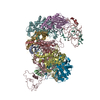
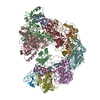
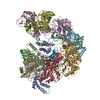


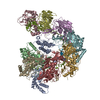
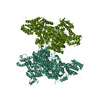
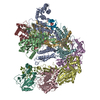
 PDBj
PDBj





























